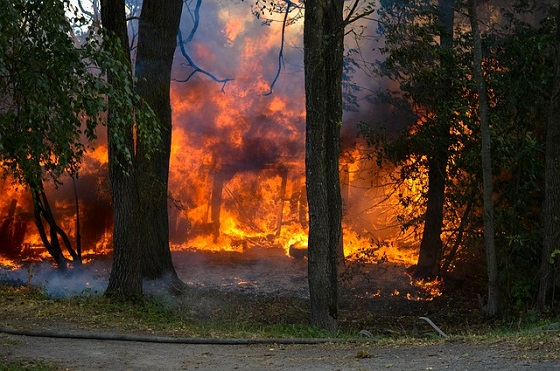Does wildfire smoke harm plants? Are garden vegetables and fruit safe to eat? How do you make your landscape less vulnerable to fire, especially if you live in a high-risk area? Learn more.
Wildfires have often been a challenge out West, though recent wildfires from Canada have brought this reality to the East Coast and other U.S. regions.
Western wildfires have been at historic levels, destroying over a million acres of land. That’s more than the size of Delaware. Tens of thousands of people in California have had to evacuate their homes, not knowing if they will have a house to go back to.
Even if you don’t live in a fire-prone area, fire can happen anywhere. Below are some tips with commonsense ways to protect your property from damage.

How Does Wildfire Smoke Affect Plants?
While wildfire smoke certainly affects humans, from headaches to breathing problems to skin irritation, plants tend to be more tolerant.
The dimmed light can certainly affect sun-loving plants if the smoke hangs around for an extended period of time. You’ll notice this issue if plants drop their leaves or their color fades.
If the smoke sticks around, plants can have trouble “breathing,” too! Tiny particulate matter can get into the plant and block openings that plants use to take in carbon dioxide and release oxygen. Plants can begin to “choke” and could suffer or be killed. You can always wipe down leaves that are coated in ash or dust. Do not water plants from above as the water makes the ash stick; always water at the soil level.
Keep in mind that wildfires can also be a positive for forests, trees, and other plants. The ash adds organic nutrients to the soil, such as calcium, potassium, and magnesium. Even some cultivated garden vegetables appreciate the nutrient boost, including lettuce, asparagus, leeks, garlic, and chives, as well as stone-fruit like peaches and plums.
Is It Safe to Eat Produce Affected by Wildfire?
If you’re harvesting during smoky conditions, the food is fine but wash off the ash outside with a hose or watering can. Then, please give it a second or third rinse inside the kitchen sink. Be gentle with the hose; don’t spray the ash around; wear a face covering while doing this.
In general, you should not see the smoke and ash penetrate deep into the fruit or vegetable. You can also peel the skins or remove the outer leaves to play it safe. That said, ash can affect the flavor of a fruit or vegetable if the ash is not easily removed. For example, wine is made by crushing grapes, skin and all. Winemakers out West have developed ways to detect ash in grapes so that it may be removed.
If the garden is heavily layered with ash, the same rules apply, but if it’s difficult to wash off the ash, you may wish to discard the product; it’s a judgment call. Of course, if your garden is located near a structure fire (which creates different toxins than a forest fire), then avoid eating any produce.
Tending to Your Property
If you live in an area (such as the West) with more wildfires, consider these tips to take care of your garden and landscape.
- Keep grass mowed and remove dead weeds or plants from your yard.
- Store wood 30 feet from the house.
- Remove dead leaves, branches, and pine cones from the roof and gutters of your house.
- Prune dead limbs from your trees. Remove any branches that hang over your roof.
- Keep any flammable outdoor furniture away from trees and shrubs.
- Remove vegetation from, around, and underneath your deck.
- Use fire-resistant mulch.
- Choose low-growing plants with a high-moisture content that makes them less flammable. (See more below.)
- Don’t plant ornamental grass or high-resin plants such as junipers, conifers, or evergreens close to your house.
- Grow deciduous trees. They are more fire resistant than evergreens because their leaves have a high-moisture content.

Growing Fire-Resistant Plants
No plant is 100% fireproof but here is a short list of plants that were recommended by the U.S. Fish and Wildlife Service:
- thyme,
- ajuga,
- succulents,
- creeping phlox,
- yarrow,
- coreopsis,
- alyssum,
- California poppies,
- coneflowers,
- columbine,
- bergenia,
- daylilies,
- lupine,
- lamb’s ears,
- iris,
- heuchera
See this wonderful firescape demonstration garden created by the city of Santa Barbara.

We hope that these tips about taking good care of your garden and landscape prove helpful. Considering how to safeguard your property from fire is especially important in high-risk areas but any of us (and our neighbors) can experience a fire on our property.














